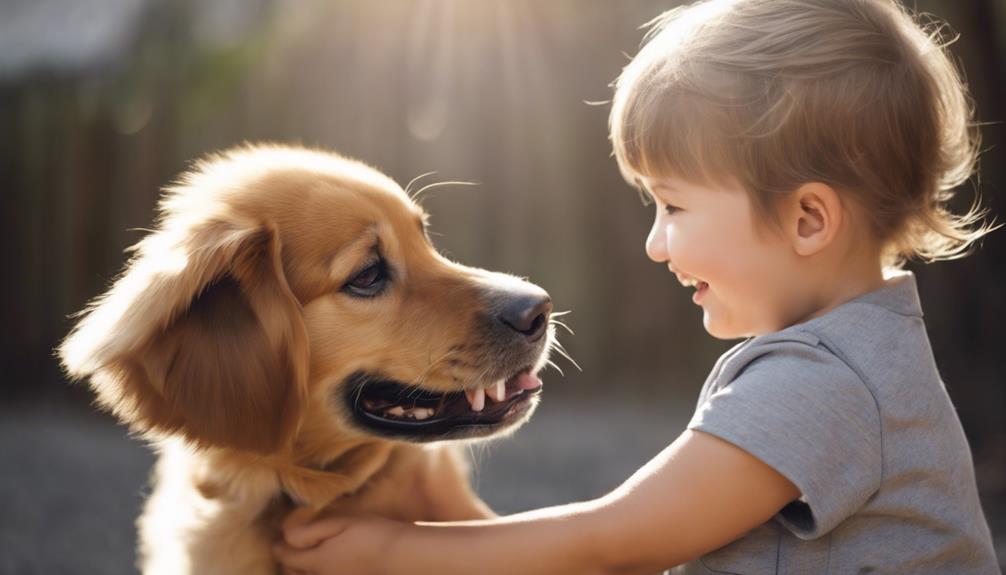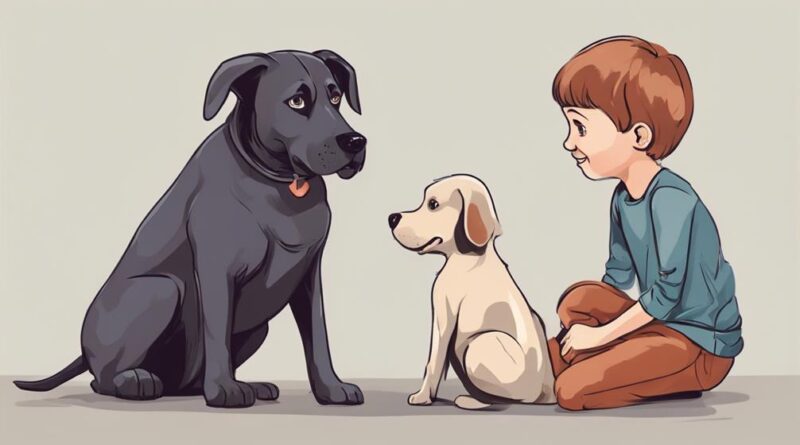Guiding Kids to Comprehend Canine Language
So, you think you've got your furry friend all figured out, huh? Well, when it comes to understanding the intricate language of dogs, there's a lot more than meets the eye.
From wagging tails to subtle ear movements, canines have a whole repertoire of signals they use to communicate with us.
But how can you ensure your kids are on the same page as Fido? Stay tuned as we explore practical tips and tricks to help your little ones decipher the mysterious language of man's best friend.
Importance of Understanding Dog Signals
Understanding dog signals is crucial for fostering safe and positive interactions between children and canines. It plays a vital role in ensuring both dog behavior and child safety. Canine communication is a key aspect of kid education when it comes to interacting with dogs. By understanding the signals that dogs exhibit, children can learn to interpret their emotions and intentions accurately. This comprehension helps prevent misunderstandings that could lead to potentially risky situations. Teaching children about dog signals not only enhances their relationship with pets but also instills a sense of empathy and respect for animals.
When children can recognize signs of fear, aggression, or playfulness in dogs, they're better equipped to respond appropriately. This knowledge empowers them to know when a dog may need space or when it's safe to approach and interact. By educating kids on canine communication, we can create a safer environment for both children and dogs to coexist harmoniously.
Common Canine Communication Cues
To better comprehend canine behavior, familiarize yourself with the common communication cues that dogs display. Canine communication basics involve both verbal and nonverbal cues that can provide insight into a dog's state of mind. Understanding these cues is essential for interpreting dog behavior and social cues correctly.
Dogs primarily rely on nonverbal cues to communicate, such as body language, facial expressions, and vocalizations. For example, a wagging tail can indicate excitement or happiness, while a tucked tail may signal fear or anxiety. Paying attention to these subtle cues can help you decipher what a dog is feeling in different situations.
In addition to body language, dogs also use vocalizations like barking, growling, or whimpering to convey their emotions. It's essential to consider the context in which these vocalizations occur to better understand what the dog is trying to communicate.
Teaching Kids to Read Dog Body Language
Help children learn to interpret dog body language effectively by observing key cues such as tail wagging and ear positioning. Understanding these signals is crucial for both dog behavior comprehension and child safety.
When a dog wags its tail loosely and at a moderate pace, it usually indicates friendliness and approachability. On the other hand, a stiff and rapid wag could signal aggression or fear.
Additionally, observing a dog's ear positioning can provide valuable insights into its mood. Ears held back could suggest anxiety or submission, while forward-facing ears often indicate alertness or excitement.
Teaching kids to recognize these signs can help prevent misunderstandings and potential conflicts with dogs. By promoting awareness of dog body language, children can learn to interact with pets more safely and respectfully.
Recognizing Dog Vocalizations
Observing a dog's vocalizations can provide valuable insights into their emotions and intentions. Dog barking and growling are common forms of vocal communication that can indicate various emotions. For instance, a deep and continuous bark may signal alertness or a perceived threat, while a high-pitched bark could indicate excitement or playfulness. Growling, on the other hand, often signifies feelings of aggression, fear, or discomfort.
Whining is another vocalization to pay attention to. Dogs may whine when they're seeking attention, feeling anxious, or in pain. It's essential to consider the context in which the whining occurs to understand its meaning accurately. Additionally, howling is a form of vocalization that can convey loneliness, response to a siren, or communication with other dogs in the distance.
Building Trust With Furry Friends
Curious about how to strengthen your bond with your furry friends? Building trust with your canine companions is crucial for a harmonious relationship. Here are some key ways to enhance your connection:
- Building Empathy: Take the time to understand your furry friend's emotions and needs. Empathy allows you to connect on a deeper level and respond appropriately to their cues.
- Establishing Boundaries: Clear boundaries help your furry friend feel secure and know what's expected of them. Consistent rules create a sense of structure and safety in the relationship.
- Regular Positive Reinforcement: Reward good behavior with treats, praise, or playtime to reinforce positive actions and strengthen the bond between you and your furry friend.
- Quality Time Together: Spend quality time engaging in activities your furry friend enjoys. Whether it's going for walks, playing games, or simply cuddling, bonding activities create lasting connections.
- Respect Their Space: Just like humans, dogs need their own space at times. Respect their need for solitude and provide a safe and quiet area where they can relax undisturbed.
Playful Vs. Warning Behaviors in Dogs
Understanding the distinction between playful and warning behaviors in dogs is essential for fostering a safe and positive interaction with your canine companion.
During playful playtime, dogs exhibit interactive cues that signal their enjoyment, such as wagging tails, relaxed body postures, and playful barks. These behaviors typically indicate a desire for fun and engagement.
On the other hand, warning signals can include growling, raised fur, tense body language, and showing teeth. It's crucial to pay attention to these cues as they communicate discomfort, fear, or a desire for space. Misinterpreting these warning signs can lead to misunderstandings and potential conflicts.
To ensure a harmonious relationship with your dog, teach children the importance of recognizing and respecting these cues. Encourage them to observe the dog's body language and respond appropriately. By promoting a deeper understanding of canine behavior interpretation, you can help create a safe environment where both children and dogs can interact respectfully and enjoyably.
Encouraging Respectful Interactions With Dogs

To promote safe and positive interactions with dogs, it's important to instill in children the significance of respecting canine cues and behaviors. When guiding kids in their interactions with dogs, it's crucial to emphasize dog safety and the importance of setting respectful boundaries. Here are some key points to consider:
- Always ask the dog's owner for permission before approaching or petting a dog.
- Teach children to approach dogs calmly and avoid sudden movements that may startle them.
- Encourage kids to observe a dog's body language for signs of discomfort or aggression.
- Instruct children to never disturb a dog while it's eating, sleeping, or caring for puppies.
- Emphasize the importance of letting a dog come to them for interaction, rather than imposing themselves on the dog.
Practicing Safe Dog Communication Skills
When interacting with dogs, always be attentive to their cues and signals to ensure safe and respectful communication. Understanding dog behavior and nonverbal cues is crucial for fostering safe interactions between kids and dogs.
Dogs communicate through body language, vocalizations, and facial expressions. Teach children to approach dogs calmly and to avoid sudden movements that may startle the dog. Encourage kids to observe the dog's body posture; a relaxed dog with a wagging tail is usually friendly and approachable, while a dog with a stiff body, raised fur, or growling may be feeling anxious or defensive.
It's important to teach children never to disturb a dog that's eating, sleeping, or caring for puppies. Additionally, instruct kids to always ask for permission from the dog's owner before petting a new dog.
Frequently Asked Questions
How Can Kids Safely Approach a New Dog They've Never Met Before?
When approaching a new dog, it's crucial to start by observing the dog's body language. Approach slowly, allowing the dog to sniff your hand. Avoid making sudden movements and maintain a calm demeanor.
Remember to always ask the owner for permission before petting the dog. By building trust through a proper approach and respecting boundaries, you can ensure a positive interaction with the new dog you've never met before.
What Should Kids Do if a Dog Starts Growling or Showing Signs of Aggression?
If a dog starts growling or showing signs of aggression, it's crucial that you stay calm and avoid making sudden movements.
Remember, the dog may be feeling scared or threatened, so it's essential to give them space.
Don't try to approach or touch the dog. Slowly back away while keeping eye contact with the dog.
Find a safe place to go and seek help from an adult if needed. Your safety comes first.
Are There Any Specific Breeds of Dogs That Communicate Differently Than Others?
Certain breeds of dogs indeed communicate differently from others. Each breed has its own unique communication styles based on their history and purpose. Understanding these breed differences can help you interpret their social cues accurately.
Training techniques should be tailored to suit the specific breed's communication style to ensure effective communication between you and your canine companion. By recognizing and respecting these differences, you can build a stronger bond with your furry friend.
How Can Kids Help a Shy or Scared Dog Feel More Comfortable Around Them?
To help a shy or scared dog feel comfortable around you, start by moving slowly and speaking softly. Avoid making sudden movements or loud noises. Offer treats and let the dog approach you at their own pace. Building trust takes time, so be patient and gentle.
Pay attention to the dog's body language and adjust your behavior accordingly. By reading their cues and creating a bond based on respect, you can help the dog feel more at ease.
Is It Possible for Kids to Misinterpret a Dog's Body Language Signals?
Yes, kids can misinterpret a dog's body language signals. When they lack understanding, there may be confusion about the dog's cues.
Communication barriers can lead to misunderstandings. It's crucial to teach kids how to correctly interpret canine body language to ensure safe interactions.
With proper guidance, children can learn to read a dog's signals accurately and establish positive relationships with their furry friends.
Conclusion
Now that you've learned how to guide kids in understanding canine language, you can help them develop safe and respectful interactions with dogs.
By teaching them to recognize common communication cues, body language, and vocalizations, they can build trust with their furry friends.
Encouraging playful behaviors while also understanding warning signs will ensure a positive relationship between kids and dogs.
Remember, communication is key in fostering a happy and healthy bond between children and their canine companions.
